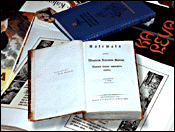
![]() Lönnrot
spent the most energetic years of his adult life in Kainuu. He was 32
when he moved to Kajaani and 51 when he returned to Helsinki to pursue
a career at the university. The bulk of his writing also took place during
this period. Naturally, his crowning achievements are the Kalevala
(The Old Kalevala (1835) and the new Kalevala (1849)) and
the Kanteletar (1840), but he accomplished a great deal more in
the literary sphere. He was also one of the foremost journalists of his
time.
Lönnrot
spent the most energetic years of his adult life in Kainuu. He was 32
when he moved to Kajaani and 51 when he returned to Helsinki to pursue
a career at the university. The bulk of his writing also took place during
this period. Naturally, his crowning achievements are the Kalevala
(The Old Kalevala (1835) and the new Kalevala (1849)) and
the Kanteletar (1840), but he accomplished a great deal more in
the literary sphere. He was also one of the foremost journalists of his
time.
While working as district physician in Kajaani, Lönnrot contributed a
total of 98 articles to eleven newspapers and magazines throughout Finland
these articles often being spread out over several issues. He contributed
most diligently - a total of 30 articles - to Helsingfors Morgonblad,
which was edited by J.L. Runeberg. Other newspapers he submitted articles
to between 1833 and 1855 included Wiikko-Sanomat in Oulu, Sanan Saattaja
in Vyborg, Borgå Tidning, Suomi, Saima, Maanmiehen Ystävä, Finland Allmänä
Tidning, Suometar,  Litteraturbladet
and Kanava. In addition, he founded his own magazine, Mehiläinen, publishing
a total of 42 issues in 1836-37 and 1839-40. He was also temporarily an
editor for Wiikko-Sanomat in Oulu (1852-1853) and Litteraturbladet (1847-49).
He published his histories of the world, Finland and Russia as supplements
to Mehiläinen. He also presented Kainuu and its history to his readers.
He hired assistants for his magazine from Kainuu.
Litteraturbladet
and Kanava. In addition, he founded his own magazine, Mehiläinen, publishing
a total of 42 issues in 1836-37 and 1839-40. He was also temporarily an
editor for Wiikko-Sanomat in Oulu (1852-1853) and Litteraturbladet (1847-49).
He published his histories of the world, Finland and Russia as supplements
to Mehiläinen. He also presented Kainuu and its history to his readers.
He hired assistants for his magazine from Kainuu.

![]() In
addition to the Kalevala and the Kanteletar, Lönnrot published two extensive
works on folklore while he lived in Kainuu: The Proverbs of the Finnish
People (1842) and The Riddles of the Finnish People (1844). Other works
dealing with folk poetry were his Om närvarande tids poesie hos Finska
Allmogen (Modern Poetry ...), which appeared in 1842, and Paavo Korhonen's
Wiisikymmentaä runoa ja kuusi laulua (Fifty Poems and Six Songs
(1848))
In
addition to the Kalevala and the Kanteletar, Lönnrot published two extensive
works on folklore while he lived in Kainuu: The Proverbs of the Finnish
People (1842) and The Riddles of the Finnish People (1844). Other works
dealing with folk poetry were his Om närvarande tids poesie hos Finska
Allmogen (Modern Poetry ...), which appeared in 1842, and Paavo Korhonen's
Wiisikymmentaä runoa ja kuusi laulua (Fifty Poems and Six Songs
(1848))


